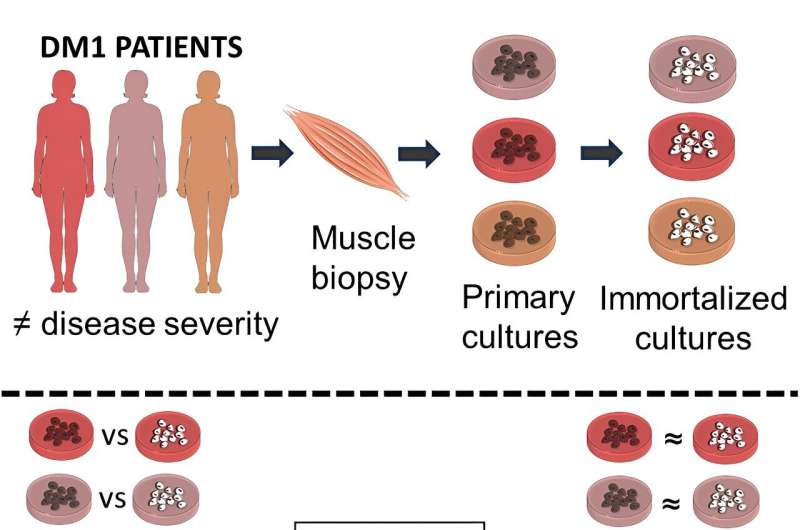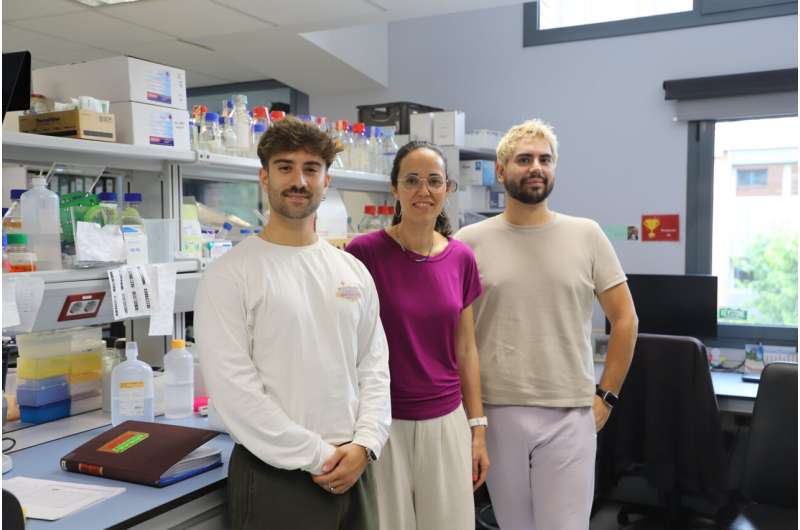This article has been reviewed according to Science X's editorial process and policies. Editors have highlighted the following attributes while ensuring the content's credibility:
fact-checked
peer-reviewed publication
proofread
New cellular models of myotonic dystrophy type 1 reflect the clinical diversity of the disease

Cellular models used to search for new therapies for myotonic dystrophy type 1 do not usually take into account the diversity of subtypes presented by patients. A study led by researchers from the Germans Trias i Pujol Research Institute (IGTP) has taken a step forward by developing three new models that represent this heterogeneity.
The results have been published in the journal iScience.
Myotonic dystrophy type 1 (DM1) is a hereditary disease of genetic cause. The gene associated with this dystrophy presents the same sequence of three nucleotides repeated at one of its ends. In a person without DM1, the gene is repeated between five and 35 times, but those affected suffer from a phenomenon of genetic expansion that can reach up to a thousand repetitions in the most severe cases.
This expansion causes abnormalities in the function and expression of the gene with various effects at the molecular level that result in tissue damage in the muscles, heart, or nervous system.
DM1 is the most common muscular dystrophy in adults, affecting one in 8,000. However, the age at which symptoms first appear can vary widely among those affected and determines the course of the disease. Patients with an earlier onset age - juvenile, infantile, or even congenital - tend to be more severely affected.

Beyond classical cellular models
Researchers from the Badalona Neuromuscular Research Group (GRENBA) at IGTP have observed that, currently, the differences among DM1 patients are not adequately addressed in the laboratory. The group leader, Gisela Nogales, says that taking these into account "is very relevant in terms of the development of new therapies."
In this process of studying and testing new treatments, scientists use cellular models, i.e., populations of cells derived from a single one that can proliferate indefinitely under controlled conditions. These experimental systems allow the study of a wide range of biological processes in the laboratory.
Current cellular models of DM1 are often not representative of the clinical reality of a significant proportion of patients. GRENBA researchers, in collaboration with scientists from the University of Belgrade, IIS Biogipuzkoa, and Institut de Myologie, have taken cell lines from three different subtypes of patients—with juvenile, adult, and late onset ages—and immortalized and thoroughly analyzed them.
Ready to test future therapeutic options
The results of the study reveal that the immortalized cell lines faithfully reproduce the main molecular features of DM1. Additionally, these cell models show great heterogeneity both in the size of the genetic expansion and in other molecular alterations of the disease.
Nogales explains that "our work shows that these new cell models are suitable for studying the pathophysiological differences in DM1 and for testing future therapeutic options." She also hopes that the models "will help to address clinical variability more precisely."
Judit Núñez, a pre-doctoral student at GRENBA and first author of the study, says, "These new cell models come at an appropriate time as there is a lot of therapeutic research going on in myotonic dystrophy and they represent a very reliable model to test the possible effects on skeletal muscle, which is one of the most affected tissues in these patients."
She adds that "these models are now available to the scientific community because we want the scientific advances produced through their use to reach patients as soon as possible."
The authors have tested the three cell models described in the study with therapeutic treatments for DM1 that have already been tested in other models and all have shown a satisfactory response.
This underlines their potential for validation of existing and future therapies, providing a reliable platform for research and drug development.
More information: Judit Núñez-Manchón et al, Immortalized human myotonic dystrophy type 1 muscle cell lines to address patient heterogeneity, iScience (2024). DOI: 10.1016/j.isci.2024.109930



















